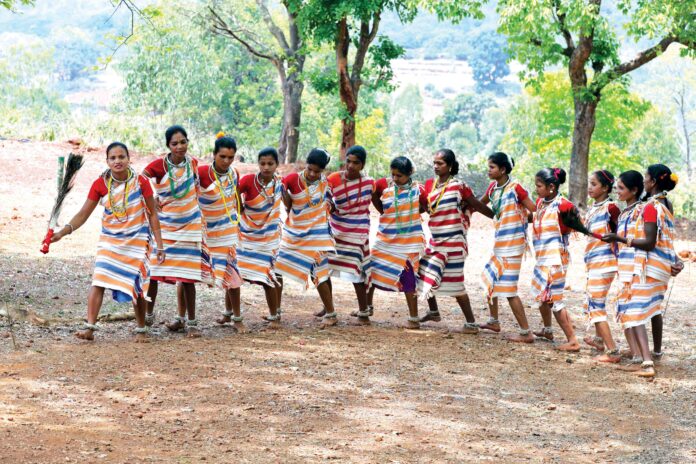From acrobatic dances to soul-stirring songs and earthy weaves, Goa is all
set to celebrate the ‘Living Heritage of Jharkhand and Odisha’
ADITHI SHARMA | NT BUZZ
With the masked acrobatics of Chhau and the lyrical dances of the Gadaba tribe and more, Goa is set to host a vivid celebration of India’s rich eastern traditions this week. The International Centre Goa (ICG) will transform into a vibrant cultural mosaic from May 9 to 11, as Contact Base and Axis Bank Foundation present a heritage festival spotlighting the living traditions of Jharkhand and Odisha, alongside Maharashtra.
The initiative, rooted in the belief that culture and livelihood are intrinsically linked, offers Goan audiences a rare opportunity to experience folk traditions through performance, craft, and dialogue. “We are not only showcasing the artistic richness of these regions but also the lives and identities of the communities that sustain them,” says founder of Contact Base and curator of the festival, Amitava Bhattacharya.
The festival places a particular emphasis on Jharkhand’s celebrated Chhau dance—a UNESCO-recognised Intangible Cultural Heritage of Humanity. Chhau has three stylistic forms – Seraikela, Kharsawan, and Manbhum (Purulia).
Seraikela Chhau, performed with small, expressive masks, carries a semi-classical elegance. In Goa, the troupe will be doing a performance of ‘Devdasi’, a devotional offering to Lord Jagannath. “It is deeply spiritual, using gesture and grace to convey prayer,” says troupe leader
Vijay Sahu.
Kharsawan Chhau, by contrast, is maskless and relies on painted faces and intense physical expression. Nandolal Kumhar, its lead performer, will enact the mythological tale of Krishna’s miraculous birth. “Through dance, we depict the divine escape of the infant Krishna from King Kansa—a story of hope and resilience,” he explains.
Then there is the more vigorous Manbhum Chhau, with its dramatic masks and martial moves. “We perform the story of Matsyasura, the demon who defied the gods until Ganesha intervened,” says Bangshidhar Mahato, who performs this energetic form. “It is a tale of good triumphing over evil, and our dance brings it
to life.”
From the Koraput region of Odisha come the Gadaba tribal dancers, who embody a lifestyle closely tied to the natural world. “Our songs and dances speak of the land, seasons, and rituals that define us,” says Manas Muduli, who leads the troupe. “We come from an agrarian tradition where music and movement mark the rhythms of life—planting, harvest, prayer.”
The festival also features craft showcases that illustrate Odisha’s and Jharkhand’s deep-rooted sustainable practices. Among them are the Ikkat and Kotpad weaves—both bearing Geographical Indication (GI) tags. “These are not just textiles,” explains Bhattacharya. “They are narratives in thread, often reflecting tribal belief systems and local cosmology.” Kotpad’s natural dyeing techniques and Subarnapur’s complex Ikkat motifs will be presented alongside terracotta craft traditions and Maharashtra’s Bohada mask-making, and Warli painting, anchoring the exhibition in everyday artistry.
“To represent culture as a living dialogue, we included lecture-demonstrations, craft process showcases, and artist-audience interactions,” says Bhattachary, adding that the choice of Goa as a host location was intentional. “Goa’s cosmopolitan outlook, combined with its cultural curiosity, makes it a welcoming space for traditions from across India,” says Bhattacharya. “Its audiences are engaged and respectful, and venues like ICG offer the perfect architectural setting for both performance and participation.”
But organising such a festival is not without challenges. Many performers come from remote regions with limited transport access and minimal exposure to urban venues. “But the biggest challenge is ensuring authenticity without alienating contemporary audiences,” admits Bhattacharya.
To this end, community elders and master practitioners have been central to the planning process. “We ensure that traditional aesthetics are preserved, even as we present them in formats that are accessible and engaging,” he says.
Another strength of the initiative lies in its collaboration with local institutions. In Odisha, Contact Base has partnered with the Council of Analytical Tribal Studies (COATS) and the ODI Art Centre in Barkul. In Jharkhand, they work with the Nimdih Gandhi Ashram, which supports training and performance spaces for traditional artists.
The performers themselves view the festival as more than an event—it is a platform for cultural continuity. “Presenting our dance in Goa is an honour,” says Mahato. “It helps people understand the roots of our stories and why they matter.” Kumhar echoes this. “Audiences in cities may not know our rituals. But through dance, we can connect. They may not understand the words, but they feel the spirit.”
Muduli sees the festival as a way of sharing lived wisdom. “We don’t perform for fame,” he says. “We dance to honour our ancestors, to keep our traditions alive.”
And this sense of legacy is precisely what the organisers hope to promote. “Cultural integration begins with recognition,” Bhattacharya explains. “When we see and hear each other’s stories, we understand we are not so different.”
The festival is not only a tribute to tradition but a bridge to the future. “We are building intergenerational transmission systems,” says Bhattacharya. “In Seraikela, we have ongoing workshops where gurus train the next generation. Events like this reinforce their value and visibility.” In the age of digital media and rapid modernisation, platforms like these remind us of the quiet strength of continuity. “These are not relics,” says Bhattacharya. “They are roots.”
(The Jharkhand-Odisha-Maharashtra heritage festival will be held at The International Centre Goa, Dona Paula, from May 9–11. Entry is free.)


